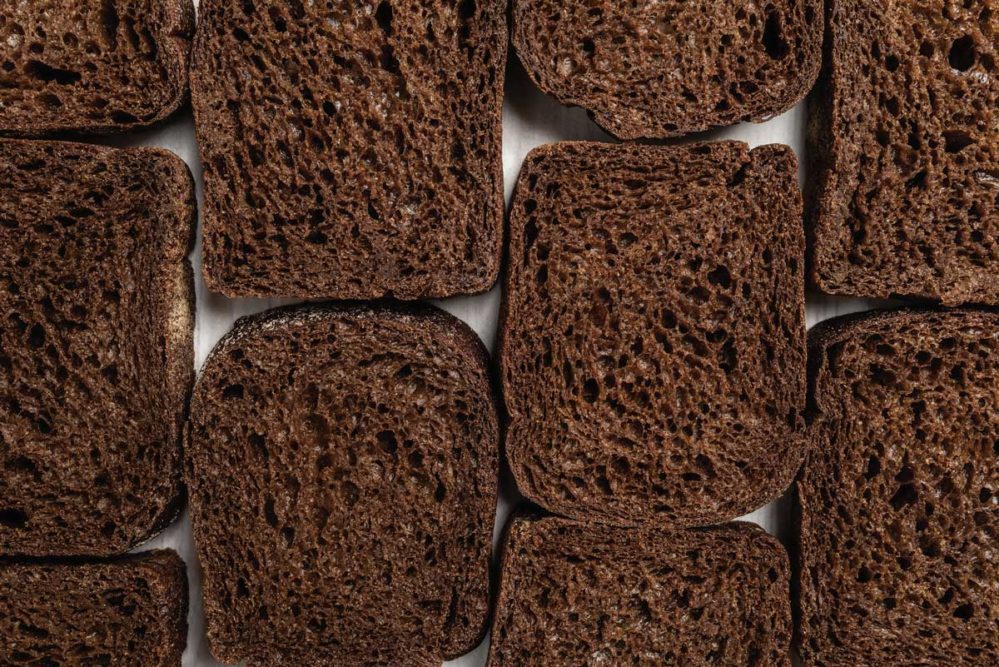Adding color to baked foods is an art and science. While colors are sometimes added strictly for fun, other times they promote authenticity and even quality. For example, consumers expect products to have some brown color, which is the result of the Maillard reaction. Caramel colors may enhance the brown hue, which in some applications, consumers perceive as premium.
“In today’s baking business world, caramel colors add richness to quickly brown baked goods that may not have enough time in industrial ovens to achieve the desired brownness,” said Brian Sethness, executive vice president of sales and marketing, Americas, Sethness Roquette. “Caramel color helps pumpernickel bread darken, the same as with rye. The dark swirl in many marble ryes is created by incorporating caramel color.”
The same is true for the swirl in cinnamon raisin breads and bagels. Egg bagels, however, often rely on yellow-toned caramel color to achieve a golden “yolk” hue.
With chocolate baked foods, caramel colors enable cost savings by limiting the use of cocoa. They also are used with artificial vanilla to make it look like real vanilla bean extract.
“Our light, red-tone powdered caramel colors are used in blends to reduce cocoa usage by as much as 40%,” Mr. Sethness said. “Our darkest caramel colors are used in blends to reduce the need for expensive alkalized [Dutch] cocoa powder by approximately 30%.”
To differentiate in the crowded marketplace, bakers will often layer flavors. Sometimes this means combining two or more fruit flavors. Other times it’s about adding an element of surprise.
“You can deliver more depth of flavor with nuances, such as that of salt, smoke, honey or coffee,” said Tracy Snider, marketing director, Balchem. “Take grilled peach inclusions, for example. We’ve translated this favorite fruit-based dessert to a piece that tastes like caramelized fresh peaches.”
Seasonal inclusions add color and flavor and enable bakers to easily offer limited-time offerings.
“Inclusions are the perfect way to develop new on-trend baked goods faster,” Ms. Snider said. “They bring excitement to bakery items through color and flavor combinations. We’ve brought the indulgence of rosé wine into a colorful strawberry inclusion that bakes great into a cake.”
When tapping into Asian flavor trends, Ms. Snider suggested adding azuki (red bean) inclusions to a green tea muffin to create an earthy, savory sweetness along with a desirable bright red color.
Colors can add dimension to baked goods. Soaking oats or quinoa in natural colors then drying them out, for example, then using the colored grains as an inclusion in baked foods or even as a topping adds a pop of color, explained Stephanie Ferretti, inside sales, GNT USA.
“The addition of yellow hues from turmeric or other fruit and vegetable juice colors can help brioche as well as butter, honey and Hawaiian products stand out from the other varieties,” Ms. Ferretti said. “The color lets consumers know to expect more flavor than a white variety.”
Some natural colors pose challenges. Red shades, for example, may not survive baking temperatures.
Chr. Hansen has developed a sweet potato pigment source using traditional breeding techniques. It has application in all types of baked foods, including fruit fillings as well as extruded products and baked snacks.
“These sweet potatoes offer a brilliant, ultra-stable red color that can replace carmine and Red 40 in many applications,” said Susan Frecker, senior application scientist, natural colors division, Chr. Hansen, Inc. “The color has good light and heat stability, resists oxidation, has no off-flavor and is very stable at low pH.”
Food Ingredient Solutions developed a new heat-stable beet red pigment specifically for red velvet cake.
“And we’ve encapsulated natural pigments that function like lakes, making them a natural alternative to synthetic lakes in fondants and frostings,” said Jeff Greaves, president, Food Ingredient Solutions. A lake food color is an insoluble material that tints through dispersion. They are very versatile and stable but not a natural color solution.
Most savory crackers rely on flavors for aroma. Flavors also enhance the intended taste of the cracker, which may come from herbs, spices or cheese ingredients.
“The level of commodity cheese needed to achieve the desired flavor impact may negatively affect the machinability of the dough as well as challenge the fat and sodium content on the nutritional panel,” said Anne Druschitz, corporate research chef, The Edlong Corp. “Switching to a cheese powder can alleviate some of these issues but pricing, availability and taste impact still may be less than ideal.
“A concentrated cheese flavor can help you either reduce the amount of commodity cheese or remove it entirely while providing the impact, batch-to-batch consistency and heat-stability needed for a successful product,” she continued.
Cheese flavors also allow bakers to take advantage of specialty cheeses without breaking the bank. Brie, gouda, feta and Romano get a lot of attention from consumers, but the supply of these cheeses usually goes to foodservice or retail grocery stores, Ms. Druschitz explained. To offset the gourmet price of these cheeses, bakers can use a little of the real cheese and enhance the impact with natural flavors.
While they may be considered minor ingredients, colors and flavors have a big impact and can close the sale of a product. As Kathy Sargent, global strategic innovation director for Corbion, concluded, “Never forget, before consumers pick up an item, they evaluate it with their eyes. In a way, they’re consuming it visually before they experience it through any of their other senses.”
This article is an excerpt from the May 2020 issue of Baking & Snack. To read the entire feature on colors and flavors, click here.





